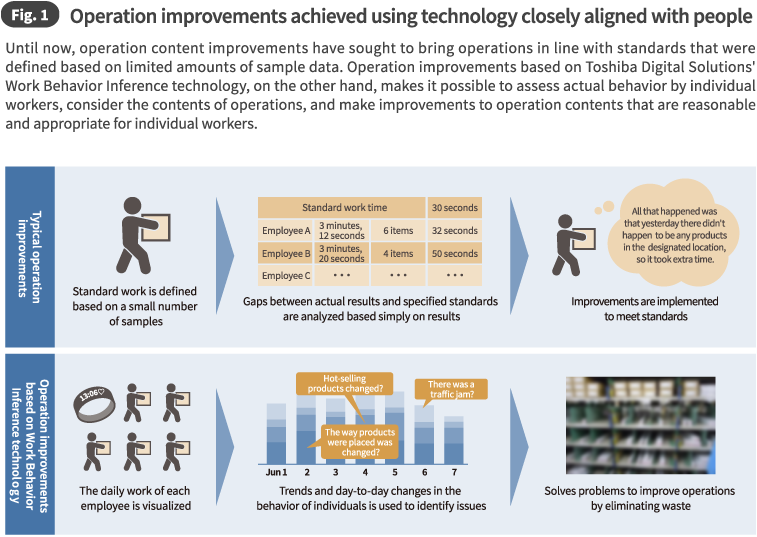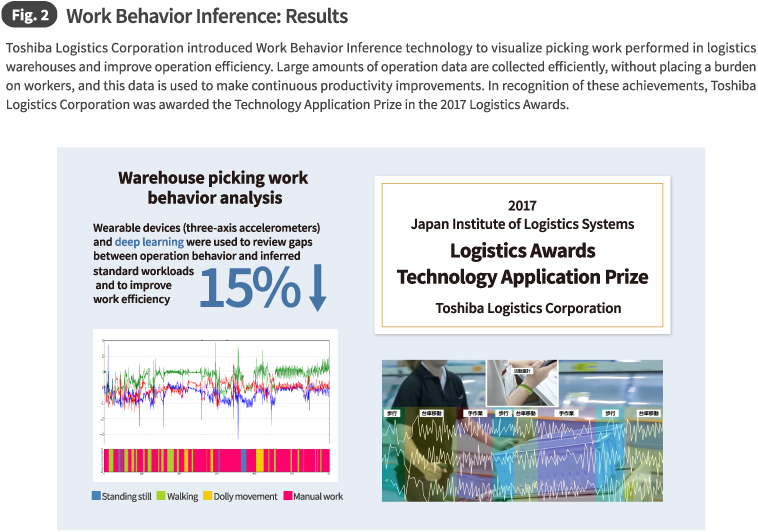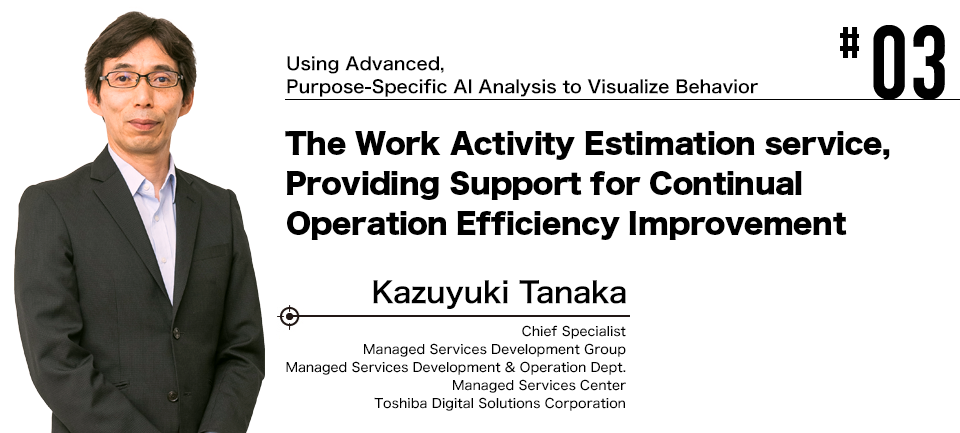Toshiba managed service Albacore is a new choice for those who wish to keep pace with drastic changes happening in the business world while maintaining reliability. One of Albacore's critical missions is to provide SaaS solutions that leverage advanced digital technologies. Toshiba Digital Solutions is driving forward with the managed service deployment of Toshiba analytics AI SATLYS, with which it has developed an extensive track record in manufacturing sites and social infrastructure. It offers a line of SATLYSKATA services, which continuously use advanced AI analysis based on customer objectives and operation issues, improving accuracy and operation quality. In this issue, we introduces one part of the SATLYSKATA lineup, SATLYSKATA Work Activity Estimation service.
SATLYS, a "Physical Object-Related AI" with a Growing Usage Track Record
Toshiba Digital Solutions provides two AI services: SATLYS, an analytics AI, and RECAIUS, a communication AI. RECAIUS identifies the intents of human speech and action, as well as their corresponding situations. It is a "human-related AI" that supports interpersonal communication. SATLYS, on the other hand, is a physical object-related AI. SATLYS uses the manufacturing expertise Toshiba has cultivated over its long history to analyze a wide range of IoT data, such as inspection data, sensor data, operation data, and behavior data, to assist with the development of new insights. By inferring causes and detecting abnormalities with a high degree of accuracy, predicting failures, inferring behavior, and even assisting with value chain optimization and process control automation, SATLYS accelerates customer business transformation.
SATLYS provides integrated all services including digital consulting, data analysis, system integration, and operation support. Furthermore, it applies advanced deep learning technologies to large scale analysis, and uses unique Toshiba technologies, such as automated generation of learning data, to make it possible to produce highly precise inference results even when it is not possible to prepare sufficient learning data. Its advanced capabilities have been highly praised, and it is currently used in power transmission line inspections, furnace combustion abnormality detection, and even the detection of cancer cells in medical images. SATLYS is used in diverse situations in a variety of industrial fields, and its usage track record is constantly growing.
Click here to move to the top of this page.
Using AI Optimized for Operations as a Managed Service
In order to make SATLYS's advanced digital technologies available for use to much more customers, we offer it as a managed service as the next step in its efforts to actively promote the adoption of AI in various industrial fields. We have collected the rich knowledge and experience it has cultivated through its history of SATLYS development and provision and has standardized deep learning models and analysis processes. It has then tailored them to specific objectives, evolving them into AI analysis services, and providing them in the form of an easy to use SaaS, SATLYSKATA.
Customers do not need to install systems to use SATLYSKATA. All they need to do to obtain required analysis results is to upload data appropriate for their objectives. SATLYSKATA enables even customers without specialist AI knowledge to easily perform AI analysis that can assist with business transformation. Furthermore, by continuously using SATLYSKATA, they can make use of optimized AI that meets the changing needs of their business, improving analysis accuracy and taking advantage of more advanced functionality.
SATLYSKATA offers AI in the form of a managed service, providing AI analysis tailored to individual objectives to help solve a wide range of issues encountered in the industrial field.
One of these forms of AI analysis is SATLYSKATA Maintenance Parts Inventory Optimization service*. Failure models for individual maintenance parts are created based on past maintenance history data and AI analysis is used to predict when failures will occur and support optimal inventory maintenance. Another one is SATLYSKATA Work Activity Estimation service, which offers continuous support for operation efficiency improvements in factories, logistics warehouses, and the like by visualizing peoples' behavior. These services are currently being offered as SaaS, and is described below.
* Toshiba case examples of SATLYSKATA Maintenance Parts Inventory Optimization service are introduced in detail in DiGiTAL T-SOUL Vol.24 #04.
Click here to move to the top of this page.
Features of the Work Activity Estimation service

IoT advances have made it possible to accurately assess the conditions of "things" in factories and social infrastructure, but collecting information about "people," who are closely involved with these "things" as they perform their work, has been difficult. This situation is what prompted Toshiba to develop the Work Activity Estimation service. For example, daily reports by workers are dependent on the memories of the respective individuals, so even if these records are collected, the information is not highly accurate. For example, even if collected information shows delays in specific work processes, it is not sufficient to infer the causes of those delays. Collecting data by having workers put work contents into tablet computers in fixed time intervals makes it possible to obtain accurate behavior information, but requires a large amount of data entry, which can interrupt work and decrease work efficiency.
Our Work Activity Estimation service uses data collected from sensors in wearable wristband devices. Workers merely need to wear these devices on their arms. This approach makes it possible to collect the data necessary for analysis while minimizing impact on the work itself. The devices have three-axis acceleration sensors and collect acceleration data regarding the movements of their wearers' arms. This acceleration data is analyzed using deep learning technology. Worker behavior is estimatedly categorized as either dolly movement, walking, hand work, or standing still, and this data is visualized.
These estimation results are used to improve operations in logistics warehouses, etc. In warehouse operations, where large amounts of products are stored and shipped, the key to improve operation efficiency is reviewing and revising work processes, shelf locations, and product arrangement to minimize a wasteful traffic and a movement loss of worker. However, movement routes and distances are irregular, so there is a limit in identifying actual conditions of each individual worker, and as a result, it is difficult to identify clear improvement measures.
This is why the Work Activity Estimation services used to visualize worker behavior. Factors that negatively affect efficiency can be identified from estimations about the behavior of individual workers and the amount of time taken. For example, if a large amount of time is spent in dolly movement, there may be waste in the dolly route. If specific workers spend a long time performing manual work, it may be because shorter workers are struggling to bring down products from high shelves. These findings can be used to discover specific improvements that do not place undue strain on individual workers, such as gathering frequently shipped products together near where they need to be transported, or arranging products in a way that fits the builds of workers (Fig. 1).

Click here to move to the top of this page.
Reducing Work Time by 15% and Verifying Advanced Analysis Capabilities
Toshiba Logistics Corporation, part of the Toshiba Group, has used the Work Activity Estimation service to greatly improve the efficiency of the picking work performed in its logistics warehouses. The worker behavior data acquired from the Work Activity Estimation service was used together with data from the warehouse management system, such as work logs, to visualize work contents and actual work values on an individual worker level, as well as gaps between these values and standard workload targets for how long that work should take. Product arrangements and work contents have been optimized based on the situation of each individual worker. As a result, operation times were reduced by roughly 15%* (Fig. 2).
* As of 2017. Efficiency improvements continue to be implemented.

For our customers, operation efficiency improvement is a never-ending process. The demands placed by business environments and markets change at a rapid pace, so even measures that may have once been optimal may need to be changed to solve issues that result from changes in the products that are manufactured or carried. The Work Activity Estimation service can be used to collect day-to-day operation results on a continual basis, check that when improvements implemented to address issues remain effective, keep up with the latest trends, and rapidly identify changes in work environments and peoples' behavior. One of the advantages of managed services is that they make it possible to continue performing overall optimization of peoples' behavior based on high precision estimation models while immediately responding to changes in the business environments and situations.
We are currently considering broadening the range of categories from the current four (dolly movement, walking, hand work, and standing still), as well as analyzing the behavior not only of people but of devices such as forklifts as well. We will apply the Work Activity Estimation service to a variety of industries, such as manufacturing, integrate it with various sensor systems, further increase the accuracy of its estimation models, and develop even more advanced behavior estimation technologies. We will offer the Work Activity Estimation service as a continuously evolving service.
The SATLYSKATA Series will continue to expand the service lineup specializing in purpose. The future is bright for Toshiba Digital Solutions' managed services, achieving greater effectiveness through the continued use of advanced AI analysis.
* The corporate names, organization names, job titles and other names and titles appearing in this article are those as of November 2019.











